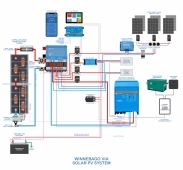childcarepro
New Member
- Joined
- Jul 5, 2020
- Messages
- 101
Yup, @Screwball and @Boondock Saint, I tried stuffing all the wiring into the Power In and the layout is MUCH prettier.


Since I was gonna get a set of Blue Sea 600A busbars + covers for about $200, I'm actually saving money by getting the Victron Power In!Hey brother, if you're gonna spend that much money on a fancy busbur set, it better be functional AND look fabulous on the Victron Red Carpet!
Yes, the shunt ends up about 1/4" lower and the switch is about 3/8" too high, so in my case I just mill out a depression for the shunt and cut an aluminum spacer plate for the switch...Also curious how you will mount switch and shunt with victron bus. They have different heights and need to be secured for road vibration.
Yes, I have the Orion 24-12/70 which is adjustable between 10V and 15V. I'll set it to 14.6 for charging the chassis lead acid battery.Looked at the Amp-l-start. It does not boost voltage, so 12v in - 12v out. Your 24-12v converter should have a voltage adjustment, depending on model.
I see @Screwball answered this one, since I haven't actually bought my switches. I think I would rather mount the Power In to a plywood spacer board with rubber bushings so the shunt can sit flush rather than inset, and use a higher spacer for the switch. Do you think that'll work, Screwball?Also curious how you will mount switch and shunt with victron bus. They have different heights and need to be secured for road vibration.
Thank you, @HRTKD!Using equal length cables, I would wire the batteries to bus bars and then the Class T fuse on the positive side and the shunt on the negative side. There is a recommendation that each battery gets its own fuse. Not many do that, but it's a good idea.
The three solar charge controllers can be connected in parallel. Have you considered a 2s3p configuration with a slightly larger controller? A single controller might be less expensive.
I'm using 200W 24V Newpowa panels x 6.I won't say that Victron equipment is 100% reliable but it's darn close.
I looked back through four pages of posts and couldn't find the specs on your solar panels. Can you post that? Have you used the Victron MPPT calculator?
I'm using 200W 24V Newpowa panels x 6.
Sorry, I thought I successfully uploaded the spec sheet. I'm camped at Wahweap Campground at Lake Powell, 0-1 bar with T-mobile and the campground's satellite internet guest wifi is terrible with good weather, we were having hailstorms yesterday. I've re-uploaded the spec sheet (EDIT: upload failed), but here are the main specs:We need the real specs. Voc, Imp, Isc, etc. It's the label on the back of the panels usually. A link to your panels will do if the full specs are there.

Thank you! That's amazing. I've tried the Victron calculator before, but couldn't quite figure it out. I'll try playing with it again.I plugged your specs into the Victron MPPT Calculator and it recommends the 150/85 using either a 3s2p or 2s3p PV configuration. The image below is for 3s2p. I know you're looking for redundancy. You can always buy a second solar charge controller and bring it along.
3s2p is easier to wire up and requires no fusing between the strings. Once you go to three strings you need to add fusing.
View attachment 67848


